Planned Pooling Crochet Basics-Basic Crisscross Pattern
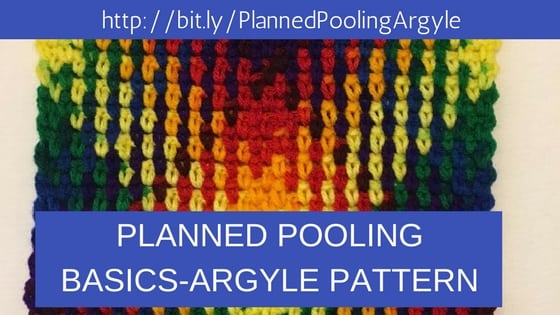 Planned Pooling Crochet 102 –how to achieve the basic crisscross pattern
Planned Pooling Crochet 102 –how to achieve the basic crisscross pattern
There are two ways to get into the pool. You can slowly wade in from the shallow end, learning how things work and taking your time to carefully plan or you can just go ahead and jump into the deep end.
This tutorial is for those of you who want to learn how things work and take the time to carefully plan your project.
*THIS POST CONTAINS AFFILIATE LINKS. BY CLICKING ONE OF THESE LINKS AND MAKING A PURCHASE A PORTION OF THE SALE WILL GO BACK TO THE BLOG. THE PRICE YOU PAY WILL NOT BE CHANGED. THANK YOU FOR YOUR SUPPORT OF THE BLOG.*
Pooling simply means the colors gather in one area to create a pool of color. There are many ways to pool variegated yarns. Some are accidental and others are more structured and planned. Any pooling pattern that you love is a great pattern.
We will address how to achieve the basic crisscross pattern using the single crochet, chain one version of the moss stitch. You can use one or two turning chains as you please. I find two beneficial as it provides an easier space to fit in the last stitch of the next row.
There are two things that are critical to getting that straight, clean, crisp pattern. The first is you need to have the same number of stitches per color consistently throughout the project. You don’t need each color to have the same number of stitches, but each instance of any one color must have the same number of stitches*.
The second thing that is critical to achieving the ninety degree angles is making sure that each color is one stitch offset from itself two rows below. This will require you to adjust your tension or use other methods to get more work from a color or to use up extra color length. See fig. 001 to understand what is meant by a one stitch offset. The first and last stitch of each color is one stitch over from where that first or last stitch was two rows below.
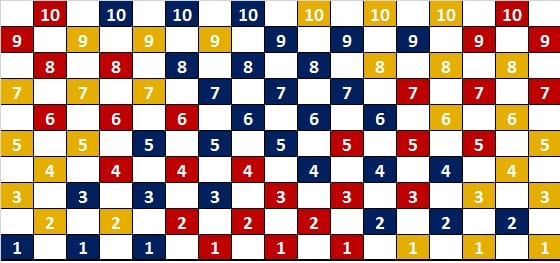
Ideally each stitch should be a single color, without any half one color and half a different color. The best way to do this is to make sure you are using the right hook size for your yarn and your personal tension. Use the information from your swatch made during hook size selection to make a color planning chart.
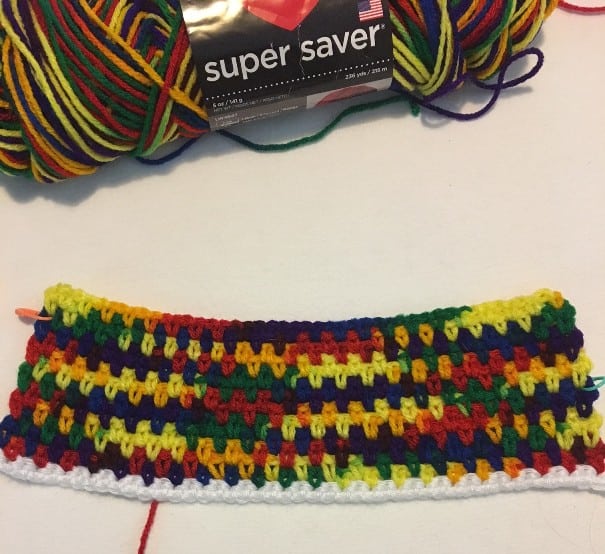

For Example:
When working through my swatch, I noticed there is a maroon section between purple and red. I decided to call this red and it is included in the stitch count in my chart.
There is also a section between blue and green that isn’t always distinctly blue or distinctly green. When working my project, I make sure I get five stitches from the beginning of green to the end of blue. That middle stitch can be mixed, but it is mostly green most of the time, so my chart reflects that as a green stitch.
There are several ways to get started; the most common way and the one this tutorial addresses is working through one color sequence.
Once you have chosen the correct hook size, make a chain longer than you want your project width to be. It doesn’t matter at all where you start in the chain and it doesn’t matter how many color sequences you work through. You can use your pooling yarn or you can use a separate yarn to create the foundation chain. I prefer to make the foundation chain in the color I intend to use for my border.
When you are ready to start your first row, you want to do so when you have a distinct color change on your hook. That is the working loop on your hook should be a different color than your last chain. If you’re using a separate yarn for the chain, slip stitch to attach your pooling yarn to the first chain after the slip knot; chain two and single crochet in the same stitch. This will give you a chain two loop on the first row to work into on the last stitch of row two. See fig. 002
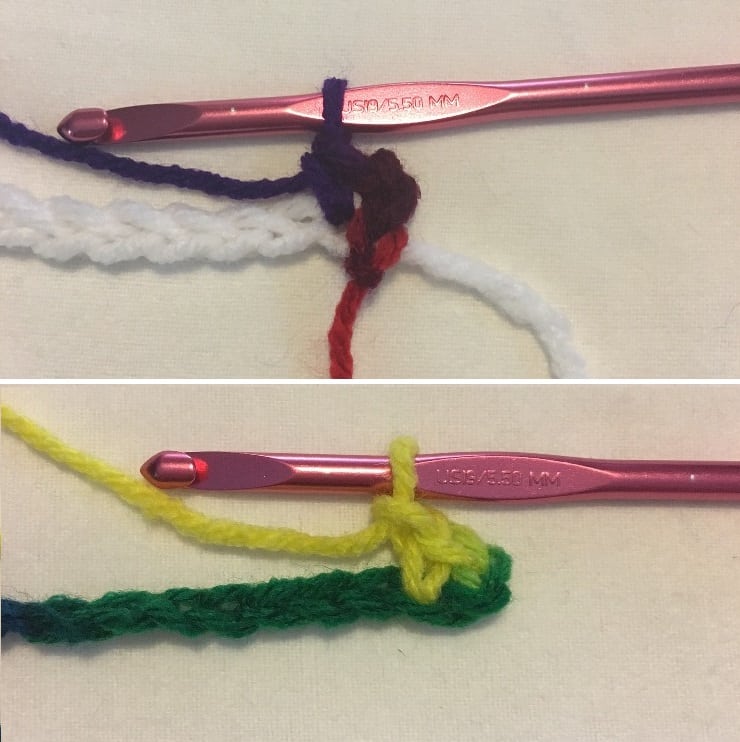
Fig. 002 Top shows starting row one with purple as the new color when using a separate yarn for the chain. Pro tip: measure the length of yarn used to slip stitch and chain one, then start that distance from your first color. Bottom shows starting with yellow as the new color when using the pooling yarn for the chain.
You then work in moss stitch through one color sequence using your planning chart to determine the number of stitches in each color. End row one with the working loop on your hook, after your turning chain(s), being the same distinct color where you started row one. I find I often have to fiddle around a bit here to get this is in just the right spot. So you may have to undo a couple of stitches in row one to make them looser or tighter, but do what you must to get the start for row two the same as the start of row one. (See fig. 003).

Notice also in fig. 004, I have worked around the starting chain for row one. This is because in row two and beyond, you will be working into a chain one space and not into a chain. It takes a bit more yarn to work around a chain than it does to work into a chain.
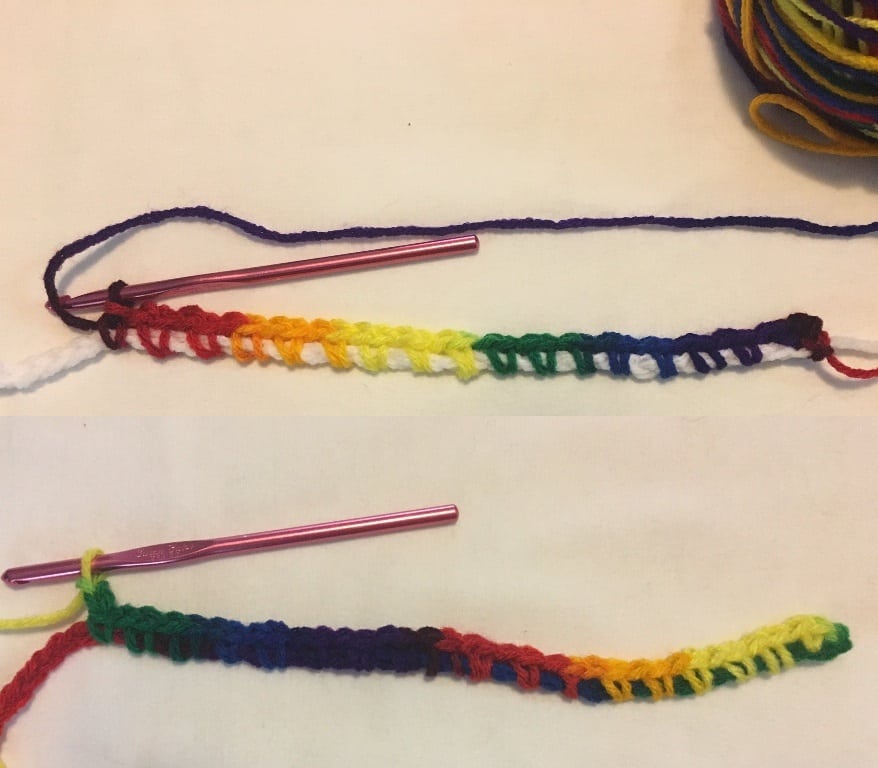
Marly explains how to work around the chain in her 10 Secrets to Perfect Planned Pooling video.
*Creating the offset will change the stitch count for one color every other row. Earlier I said you need to maintain your stitch count to get a perfect pool. There is one exception to that. To make a perfect crisscross pool, you need one additional stitch in your color sequence every other row. The total number of stitches per row doesn’t change, just the number of stitches to complete one sequence. Rocky Cee did a great tutorial on how to create the offset and have nice clean edges.
Next you will work row two making sure you get the same number of stitches as indicated in your planning chart, except for in your chosen offset color. Your row two should be an exact copy of row one, but in the opposite direction, again, with the exception of the offset color.
You can see here in fig. 005 that when I approached the end of row two, I had three spaces left to work into and I am about to start my orange. I chose orange as my offset color as I noticed it is often a little short to get three stitches.
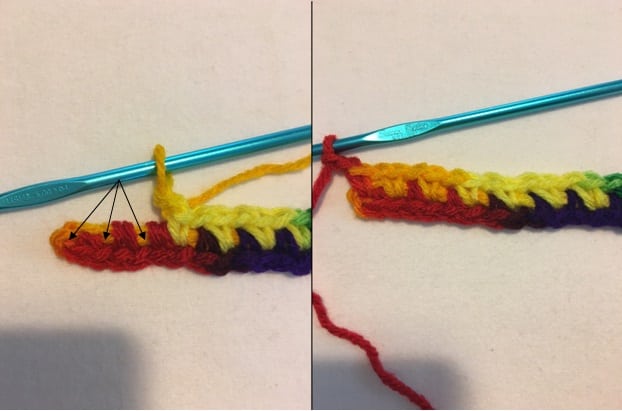
When I turn at the end of row two, having completed one red sc, I should have three left to work at the beginning of row three.
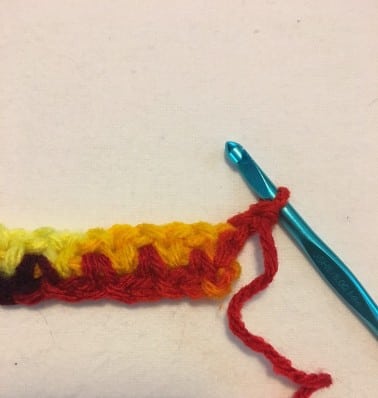
Once you have turned at the end of row two, you continue to work and as each new color appears on your hook, look two rows down to make sure you are starting one over from where you started on the previous even/odd row.
Fig. 007 below shows the diagonal lines that are created by the two up, one over offset. (You may see this referred to as one up and one over, but it is actually two rows; it is one odd/even row up).
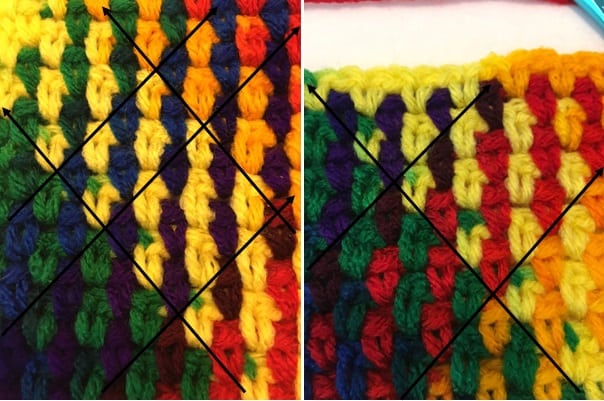 Fig. 007 Diagonal lines demonstrating the offset Ready to start row three with the remaining red.When you look at fig. 007 and your project in your hands, you will see minor imperfections, such as the green peeking through some of my yellow stitches. The amount of attention and adjustment to make a project with zero flaws is more than I am willing to take on. I still want to enjoy my crochet.
Fig. 007 Diagonal lines demonstrating the offset Ready to start row three with the remaining red.When you look at fig. 007 and your project in your hands, you will see minor imperfections, such as the green peeking through some of my yellow stitches. The amount of attention and adjustment to make a project with zero flaws is more than I am willing to take on. I still want to enjoy my crochet.
When you look at the fabric as a whole, the minor imperfections are much less noticeable. See Fig. 008 & 009.
From here, you should be able to create your masterpiece, but if you get into any trouble, please pop in to our FB group and ask for help. There is always someone there willing to help a fellow yarn crafter develop the addiction that is planned pooling with crochet.
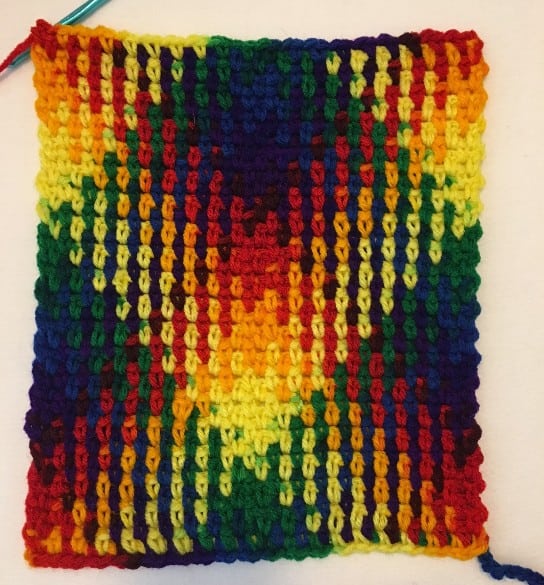
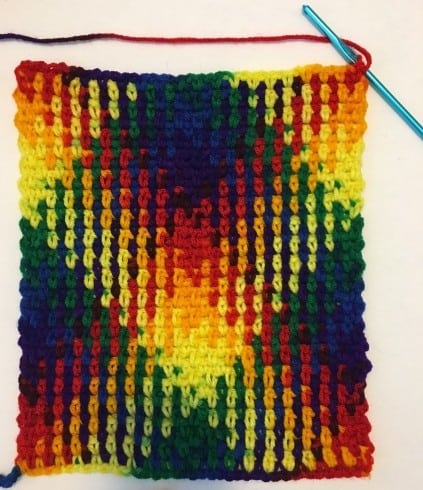
WHO IS BRENDA-LEIGH:
My name is Brenda-Leigh and I taught myself how to knit when I was seven using a book. Shortly after I began knitting my mother wanted to learn as well so I taught her. It was a great bonding experience to be able to show her something I had learned.
When I was eleven I taught myself how to crochet and my first project was a pineapple doily made with crochet thread.
I’ve continued with both over the years and have recently fallen in love with crochet. When planned pooling became popular last fall, I caught on right away and have had to opportunity to teach others. Since that early experience with my mother, I’ve loved being able to teach others and witness their success. Nothing makes me happier than giving someone that “aha!” moment.
You can find me on Ravelry as CrochetbyAlexina.
PLANNED POOLING CROCHET BLOG POSTS WITH MARLY BIRD:
Thanks so much to Brenda-Leigh for sharing with us planned pooling crochet basics. If you want to learn more about Crochet Planned Pooling you can view my other posts on the topic. Prefer learning through video? On the Marly Bird YouTube Channel you will find an entire Planned Pooling Playlist. Be sure to subscribe so you don’t miss a new video.
- The Best Crochet Planned Pooling Argyle Tutorial
- 10 Secrets to Perfect Planned Pooling in Crochet
- Planned Pooling-Finished Starting Chains
- How to create Crochet Planned Pooling Argyle Charts
- Multiple Sequence Planned Pooling Crochet
- Granny Stitch Planned Pooling Crochet
- Planned Pooling Crochet: Choosing the Best Hook Size
- Planned Pooling Crochet: Color Placement
- Planned Pooling Crochet: Deciding Where to Create Your Offset Shift
- Basics of Planned Pooling
Yarn Pooling Made Easy by Marly Bird:
Did you know that Marly has published a book on Planned Pooling Crochet? In this book, published by Leisure Arts, you will find 10 beautiful designed patterns that you can create using Red Heart yarns.

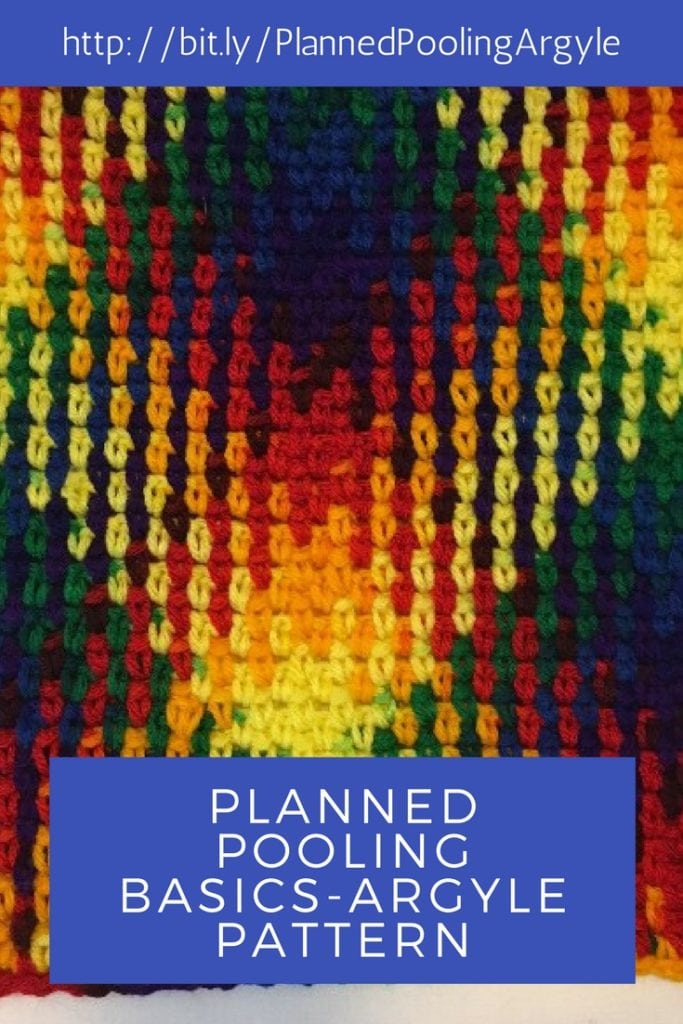












I’ve seen many places say that Red Heart With Love in Water Lily will color pool. I thought the colors were lovely and so wanted to try it for my forth color pooling scarf. I’ve worked/frogged/worked for 3 days now and can’t get it to pool! The color sections seem to be of varying lengths. I wonder if I just have a bad dye lot?